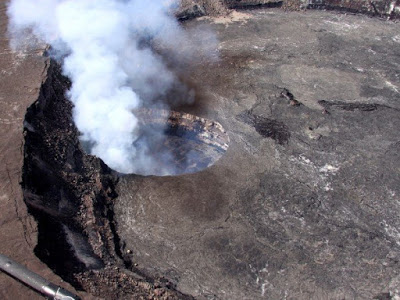
In 1980, Mount St. Helens erupted in Washington State, killing 57 people and destroying hundreds of homes. The area around the mountain became a wasteland: Roadways were swallowed and bridges damaged. Ash fell over 11 states.
Today, volcanoes rarely make the news in the United States, even though the western half of the country is dotted with volcanic systems that could unleash eruptions many times more powerful than the Mount St. Helens disaster.
“In contrast to events like hurricanes or earthquakes, volcanic unrest can last for long periods of time, and that’s one reason people stop paying attention to the hazards that are looming,” said volcanologist Greg Valentine, PhD, a University at Buffalo professor of geology and director of the Center for GeoHazards Studies in the UB College of Arts and Sciences.
To combat complacency and improve preparedness of communities near U.S. volcanoes, Valentine is heading a new research project that focuses on two locations: Kīlauea in the Hawaiian Islands, and the Long Valley caldera and volcanic field in eastern central California.
Kīlauea has been erupting continuously for more than 30 years and Long Valley — a “supervolcano” with a 20-mile-long caldera and huge explosive potential — has experienced unrest over the same period, with swarms of earthquakes rattling the area and volcanic gas rising up through the soil.
Valentine’s research, funded by a $2.9 million National Science Foundation grant, engages an interdisciplinary team to enhance disaster preparedness at both sites.
His team will advance scientific understanding of the volcanoes, studying Kīlauea’s subterranean plumbing and Long Valley’s eruptive history with the goal of refining forecasts that predict when an eruption may occur and where hazards, such as lava flows, hot gas and falling ash, could strike during such an event.
The project also will examine disaster preparedness, bringing in social scientists to assess how well communities around Kīlauea and Long Valley are prepared today and to identify better ways of communicating information on possible hazards to the public. Such steps are crucial given the danger the volcanoes pose.
Kīlauea’s ongoing eruption already has destroyed more than 200 structures, displaced families and threatened to cut off access to important roads.
The Long Valley system has the potential to release hundreds of cubic kilometers of ash in a single eruption. (For comparison, the Mount St. Helens disaster discharged about 1 cubic kilometer.)
“In some ways, the two locations we are studying are very different, but what they have in common is that they are experiencing prolonged periods of unrest,” Valentine said. “The extended period of activity can lead to complacency, where nothing dramatic is happening and stakeholders around a volcano lose sight of the real danger.
“We are engaging an interdisciplinary team to figure out how to improve resilience and preparedness in these situations where the risks are ongoing and the exact nature of the hazards that people are facing is uncertain.”
The research brings together geoscientists, engineers, statisticians and social scientists from UB, the University of Hawaii, Duke University, the University of Washington, the University of California, Berkeley, and Marquette University. The U.S. Geological Survey and Federal Emergency Management Agency also will be involved.
Note: The above post is reprinted from materials provided by University at Buffalo. The original item was written by Charlotte Hsu.









